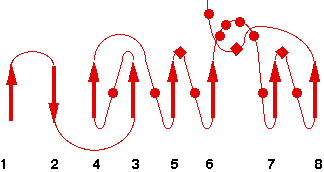6Y7A
Name : X-Ray structure of the Haloalkane dehalogenase HaloTag7 labeled with a chloroalkane-tetramethylrhodamine fluorophore substrate
Revelation date : 30-Mar-2021
Family : Haloalkane_dehalogenase-HLD2
Gene_locus : rhoso-halo1
PDB file : ESTHER: header of PDB entry RCSB: Full entry
Comment
Tarnawski, M., Johnsson, K., Hiblot, J.
Ligand :
References (2)
| Title : Engineered HaloTag variants for fluorescence lifetime multiplexing - Frei_2022_Nat.Methods_19_65 |
| Author(s) : Frei MS , Tarnawski M , Roberti MJ , Koch B , Hiblot J , Johnsson K |
| Ref : Nat Methods , 19 :65 , 2022 |
| Abstract : Frei_2022_Nat.Methods_19_65 |
| ESTHER : Frei_2022_Nat.Methods_19_65 |
| PubMedSearch : Frei_2022_Nat.Methods_19_65 |
| PubMedID: 34916672 |
| Gene_locus related to this paper: rhoso-halo1 |
| Title : Kinetic and Structural Characterization of the Self-Labeling Protein Tags HaloTag7, SNAP-tag, and CLIP-tag - Wilhelm_2021_Biochemistry_60_2560 |
| Author(s) : Wilhelm J , Kuhn S , Tarnawski M , Gotthard G , Tunnermann J , Tanzer T , Karpenko J , Mertes N , Xue L , Uhrig U , Reinstein J , Hiblot J , Johnsson K |
| Ref : Biochemistry , 60 :2560 , 2021 |
| Abstract : Wilhelm_2021_Biochemistry_60_2560 |
| ESTHER : Wilhelm_2021_Biochemistry_60_2560 |
| PubMedSearch : Wilhelm_2021_Biochemistry_60_2560 |
| PubMedID: 34339177 |
| Gene_locus related to this paper: rhoso-halo1 |
Representative scheme of Prolylcarboxypeptidase structure and an image from PDBsum server


Databases
PDB-Sum : 6Y7A Previously Class, Architecture, Topology and Homologous superfamily - PDB-Sum server
FSSP : 6Y7A Fold classification based on Structure-Structure alignment of Proteins - FSSP server
SCOP : 6Y7A Structural Classification Of Protein - SCOP server
PROTEOPEDIA : 6Y7A 3D, interactive encyclopedia of proteins - PROTEOPEDIA server